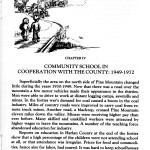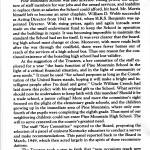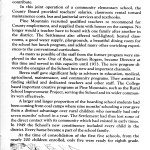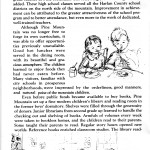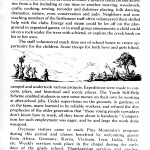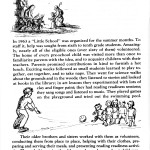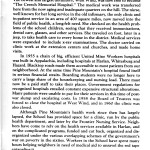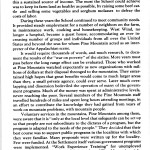Pine Mountain Settlement School
Series 04: HISTORIES
The Pine Mountain Story Chapter IV
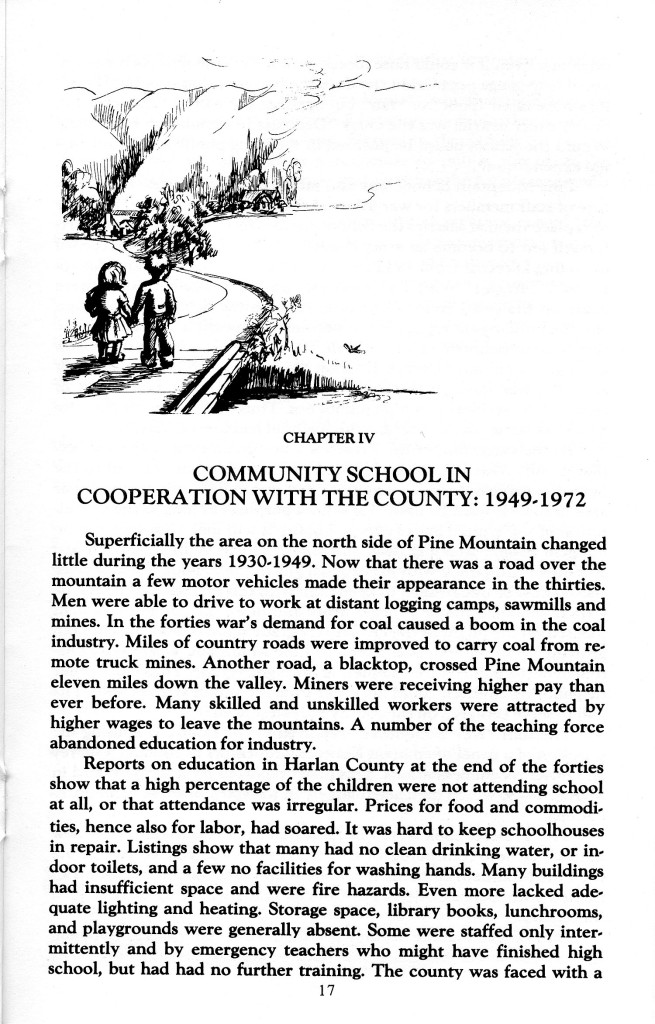
Mary Rogers: The Pine Mountain Story – Ch. IV. [pmss-story017.jpg]
THE PINE MOUNTAIN STORY Chapter IV:
“Community School in Cooperation with the County: 1949-1972.”
TAGS: The Pine Mountain Story Chapter IV, Community School in Cooperation with the County: 1949-1972, World War II effects, county schools, endowment fund, end of boarding high school, Berea College affiliation, Burton Rogers, children’s library, student activities, overseas visitors, Pre-School, health services, community employment
THE PINE MOUNTAIN STORY CHAPTER IV contains the images and transcription of Chapter IV of “The Pine Mountain Story 1913-1980.” This chapter describes the “Community School in Cooperation with the County: 1949-1972.”
The booklet was written and illustrated in 1980 by Mary Rogers. Mary was a PMSS worker for over 50 years and wife of Burton Rogers, director of the School from 1949 to 1973.
For other chapters and more about “The Pine Mountain Story 1913-1980” and the author, Mary Rogers, go to GUIDE TO “THE PINE MOUNTAIN STORY 1913-1980.”
CONTENTS: THE PINE MOUNTAIN STORY Chapter IV
Community School in Cooperation with the County: 1949-1972 ; Mary Rogers illustrations ; automobiles ; World War II effects ; coal industry ; rising prices ; county schools ; war jobs ; armed services ; Glyn Morris ; William D. Webb ; H.R.S. Benjamin ; endowment fund ; road-building ; end of boarding high school ; new Board of Trustees ; Berea College affiliation ; Board decisions ; PMSS in joint operation with Harlan County Board of Education ; Burton Rogers ; Berea staff assistance ; Rural School Improvement Project ; increase to 10th grade ; children’s library ; student activities ; after-school activities ; Youth Self-Help Scheme ; overseas visitors ; Chapel activities ; Pre-School ; Little School ; Title I ; The Creech Memorial Hospital in West Wind ; health services ; United Mine Workers hospitals ; clinics ; Frontier Nursing Service ; farm demonstration ; agri-business ; community employment ; problems with War on Poverty ; government programs at PMSS ; Work Experience Training ;
GALLERY: THE PINE MOUNTAIN STORY Chapter IV
- Mary Rogers: The Pine Mountain Story – Ch. IV. [pmss-story017.jpg]
- Mary Rogers: The Pine Mountain Story – Ch. IV. [pmss-story018.jpg]
- Mary Rogers: The Pine Mountain Story – Ch. IV.[pmss-story019.jpg]
- Mary Rogers: The Pine Mountain Story – Ch. IV. [pmss-story020.jpg]
- Mary Rogers: The Pine Mountain Story – Ch. IV. [pmss-story021.jpg]
- Mary Rogers: The Pine Mountain Story – Ch. IV. [pmss-story022.jpg]
- Mary Rogers: The Pine Mountain Story – Ch. IV.[pmss-story023.jpg]
- Mary Rogers: The Pine Mountain Story – Ch. IV. [pmss-story024.jpg]
TRANSCRIPTION: THE PINE MOUNTAIN STORY Chapter IV
[pmss_story017.jpg]
CHAPTER IV
COMMUNITY SCHOOL IN
COOPERATION WITH THE COUNTY: 1949-1972
[Illustration: Mary Rogers’ ink sketch of a small girl and boy holding hands, crossing a footbridge, and heading on path to mountainous landscape in distance.]
Superficially the area on the north side of Pine Mountain changed little during the years 1930-1949. Now that there was a road over the mountain a few motor vehicles made their appearance in the thirties. Men were able to drive to work at distant logging camps, sawmills and mines. In the forties war’s demand for coal caused a boom in the coal industry. Miles of country roads were improved to carry coal from remote truck mines. Another road, a blacktop, crossed Pine Mountain eleven miles down the valley. Miners were receiving higher pay than ever before. Many skilled and unskilled workers were attracted by higher wages to leave the mountains. A number of the teaching force abandoned education for industry.
Reports on education in Harlan County at the end of the forties show that a high percentage of the children were not attending school at all, or that attendance was irregular. Prices for food and commodities, hence also for labor, had soared. It was hard to keep schoolhouses in repair. Listings show that many had no clean drinking water, or indoor toilets, and a few no facilities for washing hands. Many buildings had insufficient space and were fire hazards. Even more lacked adequate lighting and heating. Storage space, library books, lunchrooms, and playgrounds were generally absent. Some were staffed only intermittently and by emergency teachers who might have finished high school, but had had no further training. The county was faced with a…
17
[pmss_story018.jpg]
…dilemma. Even if it could raise money to improve the schools it was impossible to gauge population trends in the post-war slump. School buildings were rated “poor” or “fair” but opposite the name of the school in nearly every district was the entry “Decrease in population expected.” Would the school board be justified in spending public money on capital expenditure?
Pine Mountain School was also affected. Rising prices, the departure of staff members for war jobs and the armed services, and inability to replace them at salaries the School could afford, hit hard. Mr. [Glyn] Morris himself left to become an army chaplain. William D. Webb succeeded as Acting Director from 1942 to 1944, when H.R.S. Benjamin was appointed Director. With rising prices, again and again inroads were made on the small endowment fund to keep the School in operation and the buildings in repair. It was becoming impossible to maintain the standard the School had set for itself. It was ever clearer that the boarding high school must change or close. Moreover, with more roads built after the war through the coalfield, there were fewer homes out of reach of the services of a high school bus. Thus one reason for the continued existence of the boarding high school had lost validity.
At the suggestion of the Trustees, a key committee of the staff explored for a year “the basic function of Pine Mountain School in the light of a critical financial situation, and in the light of community or area needs.” It must be used “for school purposes as long as the Constitution of the United States stands, hoping it will make a bright and intelligent people after I’m dead and gone.” Uncle William Creech had laid down this policy with his original gift to the School. What service should now be undertaken to keep faith with this mandate? Should it be a trade school, a junior college? More and more the committee’s sight focused on the plight of the elementary grade schools, and the children growing up in the immediate area of Pine Mountain, where only one-fourth of the pupils were completing the eighth grade. Thus most of our neighboring children could not enter Pine Mountain High School. The will to serve centered on the county’s greatest need.
The staff “Key Committee” reported to the Board, proposing the selection of a panel of eminent Kentucky educators to conduct a survey and make recommendations. This panel reported back to the Board in March, 1949, which then acted largely in the spirit of these recommendations.
The Trustees took a step in faith that “new occasions teach new duties.” A new continuing Board of Trustees was elected to operate the Pine Mountain Settlement School as an independent institution affiliated with Berea College. No College funds would be used at Pine Mountain.
It was urged that the health work should be retained, that community services should be maintained and expanded, and that the farm,…
18
[pmss_story019.jpg]
…through experiment, should “lead in the economic improvement of its neighbors.”
As further recommended, the Pine Mountain Settlement School invited the Harlan County Board of Education to bring the pupils of seven surrounding one-room school districts to the Settlement School classrooms and playgrounds as a consolidated public school, to be strengthened by the resources and extra facilities the Settlement could contribute.
In this joint operation of a community elementary school, the County Board provided teachers’ salaries, classroom rental toward maintenance costs, bus and janitorial services and textbooks.
Pine Mountain recruited qualified teachers to recommend for County employment, and supplied them with homes on the campus. No longer would a teacher have to board with one family after another in the district. The Settlement also offered well-lighted, heated classrooms, a good water supply, playgrounds, a beautiful dining room for the school hot lunch program, and added many other enriching experiences to the conventional curriculum.
As many as possible of the staff from the former program were employed in the new. One of these, Burton Rogers, became Director at this time and served in this capacity until 1973. The new program directed the energies of the School into new and important channels.
Berea staff gave significant help as advisors in education, medical, agricultural, maintenance, and community programs. They assisted in finding skilled and dedicated teachers and other staff. The College based important creative programs at Pine Mountain, such as the Rural School Improvement Project, serving the School and its wider community very effectively.
A larger and larger proportion of the boarding school students had been coming from coal camps where nine months’ schooling a year gave them a distinct advantage over rural children who normally had only seven months’ school in a year. The Settlement had thus lost some of the direct contact with its community which had existed in early times. In 1949 the School’s new constituency included every child in the district. Every home became a part of the school family.
At the time of consolidation of the first five schools, from the nearly 200 children enrolled, only five were ready for eighth grade.
[Illustration: Ink sketch by Mary Rogers of a line of school children heading toward a bus, against a mountainous background.]
19
[pmss_story020.jpg]
Three-quarters of the school, including sixteen-year-olds, were third grade level or below. In a very few years as many children had continued through the eighth grade as had entered the first. Moreover they still had two years compulsory schooling before reaching the age of sixteen. The county high school was crowded, and unprepared for this influx of students. The Settlement offered to pay half the salary of a ninth grade teacher at Pine Mountain. The following year a tenth grade was added. These high school classes served all the Harlan County school districts on the north side of the mountain. Improvement in achievement can be attributed to the greater attractiveness of the school program and to better attendance, but even more to the work of dedicated, well-trained teachers.
[Illustration: Ink sketch by Mary Rogers of two children eating at a table.]
Although Pine Mountain was no longer free to forge its own curriculum, it was able to offer opportunities previously unavailable. Good hot lunches were served in the dining room, with its beautiful and gracious atmosphere. The children learned to enjoy foods they had never eaten before. Many visitors, familiar with city schools in prosperous neighborhoods, were impressed by the orderliness, good manners, and natural poise of the mountain children.
Even before public funds became available to buy books, Pine Mountain set up a fine modern children’s library and reading room in the former boys’ dormitory. Shelves were filled through the generosity of donors. Junior librarians from second grade up learned to handle the checking out and shelving of books. Armfuls of volumes every week were taken to bookless homes, and the children read to their parents. Some taught their parents to read. Regular story hours opened new worlds. Reference books enriched classroom studies. The library read-…
[Illustration: Ink sketch by Mary Rogers of children using a library.]
[pmss_story021.jpg]
…ing room, a former living room, remained beautiful with homemade furnishings. Never once was there a case of vandalism.
Teachers introduced many new projects, including the writing and production of plays related to classroom studies. Children enjoyed sharing displays and collections with visitors. Student teachers from Berea College came at intervals to help the teachers with the large classes. Certain afternoons were devoted to clubs. Children could choose activities from a list including at one time or another weaving, woodwork, crafts, cooking, sewing, recorder and dulcimer playing, folk dancing, dramatics, nature, even conservation and judo. Neighbors and nonteaching members of the Settlement staff often volunteered their skilled help with the clubs. Energy and steam could be let off on the playground in organized games, or in small group amusements; a child could sit on a rock under the trees with a friend, or explore the creek bank on his or her own.
[Illustration: Ink sketch by Mary Rogers of children in a basketball game and on a campout against mountain background.]
The staff volunteered much time out of school hours to create opportunity for the children. Scout troops for both boys and girls hiked, camped and undertook various projects. Expeditions were made to concerts, plays, and historical and scenic places. The Youth Self-Help Scheme enabled students to earn some money on their own by working at after-school jobs. Under supervision on the grounds, in gardens, or on the farm, many learned to be reliable workers, and refuted the dire prophecies of the older generation that “these young people nowadays don’t know how to work, all they know about is handouts.” Competition for such employment was eager, and by and large the work done was good.
Overseas visitors came to study Pine Mountain’s program during this period and classes benefited by welcoming guests from Africa, Germany, Korea, Vietnam, Iran, India, Tibet, etc. Weekly services took place in the chapel during the early days of the grade school. Thanksgiving services and graduation exercises were always held there. Grade school children carried on the tradition, unbroken since 1917, of presenting the Nativity Play at Christmas time.
The most important pioneer program undertaken by Pine Mountain during this period was the Pre-School. The first grade teacher realized that many children in the county entered school totally unprepared for school life, and without skills demanded by the first grade curriculum.
21
[pmss_story022.jpg]
[Illustration: Ink sketch by Mary Rogers of Nativity Play.]
In 1963 a “Little School” was organized for the summer months. To staff it, help was sought from sixth to tenth grade students. Amazingly, nearly all of the eligible ones (over sixty of them) volunteered. The home of every pre-school child was visited more than once to familiarize parents with the idea, and to acquaint children with their teachers. Parents promised contributions in kind to furnish a hot lunch. Exciting weeks followed as small students learned to play together, eat together, and to take naps. They went for science walks about the grounds and in the woods; they listened to stories and looked at books in the library; in art lessons they experimented with lots of clay and finger paint; they had reading readiness sessions; they sang songs and listened to music. They played games on the playground and tried out the swimming pool.
[Illustration: Ink sketch by Mary Rogers of older student rolling ball towards group of young children.]
Their older brothers and sisters worked with them as volunteers, conducting them from place to place, helping with their clothes, preparing and serving their meals, and presenting reading readiness activities. Through this service the older ones learned more about child care, discipline and education, as bona fide staff members, than they could have learned in a year sitting at desks as pupils. After two years of Little School in the summer, Pine Mountain decided to sponsor and finance a year-round pre-school. Two years later this was funded by Title I.
In the early sixties government pre-school programs such as Title I and Headstart were being initiated as part of Area Renewal. The origi-…
22
[pmss_story023.jpg]
…nator of the Pine Mountain kindergarten program, having pioneered in the work here, was able to offer valuable advice from the fruit of her experience in helping train teachers for these new government programs.
The health work which had been an integral part of the Settlement program since 1913 expanded rapidly at the beginning of this period. The newest and largest dormitory, West Wind, was now free to become “The Creech Memorial Hospital.” The medical work was transferred here from the now aging and inadequate quarters on the hill. The nurse, well known for her long service in the old infirmary, the only clinic and in-patient service in an area of 400 square miles, now moved into the field of public health, a long-felt need. She checked on the health problems of the school children, seeing that they received immunizations, dental care, glasses, and other services. She traveled on foot, later in a jeep, to take health care to every home in the district. Medical services were expanded to include x-ray examinations. The doctor carried on clinic work at the extension centers and churches, and made home visits.
In 1955 a chain of big, efficient United Mine Workers hospitals was built in Appalachia, including hospitals at Harlan, Whitesburg, and Hazard. Blacktop roads made them accessible to most patients from our neighborhood. At the same time Pine Mountain’s hospital found itself in serious financial straits. Boarding students were no longer here to carry a large share of the housekeeping and nursing load. There must now be a paid staff to take their places. Government regulations for recognized hospitals entailed constant expensive structural alterations. Many patients were unable to pay for their services in this time of postwar slump and escalating costs. In 1958 the Board of Trustees was forced to close the hospital at West Wind, and in 1960 the clinic was also closed.
Although Pine Mountain’s health work since then has largely lapsed, the School has provided space for a clinic, run by the public health department, and later by the Frontier Nursing Service. Neighbors have come to rely on the health services available in Harlan, and on the complicated programs, funded and cut back, organized and disorganized under the various overlapping schemes of the government’s war on poverty in the sixties. Workers in the School have spent many hours helping neighbors in need of medical aid to unravel the red tape entangling it.
The future of the farm was optimistically envisioned as a demonstration project to determine the best uses of the land, and thus to serve as a pilot project for the neighborhood. Timing was ill-chosen for such an experiment. Pine Mountain was planning a small-scale operation with little financial backing at a time when agri-business throughout the country was pressing much larger and more productive farms out of…
23
[pmss_story024.jpg]
…business. No resident student body now existed to provide labor and to consume the products. Distance from a market made it hard to sell produce for a profit, whether milk from the dairy herd, eggs, sheep, or beef cattle. Even efforts to harvest overripe timber in the school forests, without damaging soil or watershed, proved to be an expensive undertaking, and cut into the profits. Nor was there enough acreage to make this a sustained source of income. The most the School could achieve was to keep its farm land as healthy as possible, by raising some beef cattle and selling some vegetables and sorghum molasses to defray the costs of labor.
During these years the School continued to meet community needs. It provided steady employment for a number of neighbors on the farm, in maintenance work, cooking and housekeeping. West Wind, no longer a hospital, became a guest house, accommodating an ever increasing number of groups and individuals from all over the United States and beyond the seas for whom Pine Mountain acted as an interpreter of the Appalachian scene.
It would require thousands of words, and much research, to document the results of the “war on poverty” of the sixties. More years must pass before the long range effect can be evaluated. Those who worked at Pine Mountain watched expectantly as new organizations with millions of dollars at their disposal thronged to the mountains. They entertained high hopes that great benefits would come to much larger areas than they, a small private agency, could ever serve. Later much overlapping and dissension bedeviled the operation of many of the government programs. Much of the money was spent at administrative levels, never reaching the poor. Several members of the Pine Mountain staff travelled hundreds of miles and spent long hours attending meetings, in an effort to contribute the knowledge they had gained from years of work on mountain problems, with mountain people.
Voluntary services in the mountains, Pine Mountain among them, were aware that it is “only at the local level that safeguards can be set up so that people are not subordinate to the dictates of a program, but the program is adapted to the needs of the people.” They decided that their best course was to support public programs in the localities with which they were familiar. Many proposals were written up for the locality. Few were funded. At the Settlement itself various government programs were implemented. “Work Experience Training” for unemployed fathers proved the most successful. A number of Pine Mountain neighbors gained a new start in life from this, and have been in regular employment ever since. At the time when Pine Mountain was most actively engaged in this program fifteen men were working at the School and earning income to support forty children from homes in the school district.
24
SEE ALSO:
GUIDE TO “THE PINE MOUNTAIN STORY 1913-1980”
THE PINE MOUNTAIN STORY – CH. I
Chapter I – The Pine Mountain Area Before 1913
THE PINE MOUNTAIN STORY – CH. II
Chapter II – The Early Years of Pine Mountain Settlement School: 1913-1930
THE PINE MOUNTAIN STORY – CH. III
Chapter III – The Boarding High School: 1930-1949
THE PINE MOUNTAIN STORY – CH. V
Chapter V – Environmental Education: 1972-
MARY ROGERS Staff Biography
MARY ROGERS – Drawings

